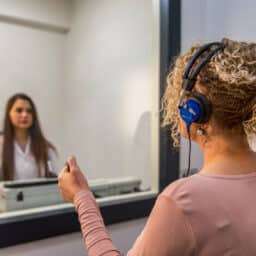Prescription Hearing Aids and Non-Prescription Hearing Aids: Considering the Options
The Food and Drug Administration’s August Ruling On October 17, 2022, the U.S. Food and Drug Administration’s (FDA) August ruling allowing for the purchase of over-the-counter (OTC) hearing aids went into effect. This exciting development has been in the works since 2017. The FDA Reauthorization Act of 2017 directed the FDA to create a category…
GE Is Retiring!

As we close out this amazing year, we would like to highlight one individual for her many years with us. GE has given Evergreen Speech and Hearing Clinic 17 wonderful years of devoted work, and now she is on to a new and exciting chapter of her life! When we asked GE to think about…
What You Should Know About Asymmetrical Hearing Loss

Asymmetrical hearing loss (AHL) refers to when your hearing loss is different in each ear. This condition is surprisingly common; according to one study, “Approximately 50% of all patients and 55% of patients with sensorineural hearing loss were classified as AHL by the clinician-validated algorithm.” Below we review everything you should know about asymmetrical hearing…
Introducing Rotary Chair Testing
Our ears house so many important structures in a tiny space! Most people know about the hearing aspect, but the peripheral balance system is also found inside of our ears. According to the CDC, millions of older individuals fall in the United States. Dizziness and falls can be profound and concerning events. Here at ESHC,…
What Does a Sharp Pain in the Ear Mean?

If you experience a sharp pain in the ear, it might be alarming. However, it is rarely cause for serious concern. Below we review some of the common causes of ear pain and how to find relief. Ruptured Eardrum If you’ve ruptured your eardrum, it means you have a hole or tear in the membrane…
Daycare and Children With Severe Hearing Loss

As a parent, you want to make sure your child is always experiencing the best care, whether at home or in a school or daycare setting. If you have a young child with severe hearing loss, you may be worried that daycare facilities won’t be able to adequately meet your child’s needs. Let’s examine what…
What Is Congenital Hearing Loss & How Is It Treated?

If a condition is congenital, it means you’re born with it. One condition that can be congenital is hearing loss. In fact, approximately two to three of every 1,000 babies have congenital hearing loss. Below we review more information about congenital hearing loss. What Are the Types of Congenital Hearing Loss? There are three types…
Get into the Spooky Spirit with Your Hearing Aids

Even though hearing loss is extremely common – affecting approximately two to three out of every 1,000 babies and one in eight people ages 12 and older in the U.S. – some people believe there is still a stigma around wearing hearing aids. Specifically, they fear that by wearing hearing aids they’ll look “old.” This…
Facts About Pediatric Hearing Loss for Audiology Awareness Month

As a parent, nothing is more important than your child’s health. In honor of October being Audiology Awareness Month, we’d like to go over the basics of pediatric hearing loss, from how it’s diagnosed to the best treatment options available. Most Infants Are Screened for Hearing Loss Shortly After Birth The vast majority of newborns…
What Causes Temporary Hearing Loss in Children?

If your child is complaining that things sound funny or it seems like they can’t hear as well as you talk to them, don’t immediately assume the worst. Not all hearing loss is permanent, and they may be dealing with a condition that is causing temporary hearing loss. Let’s look at a few of the…